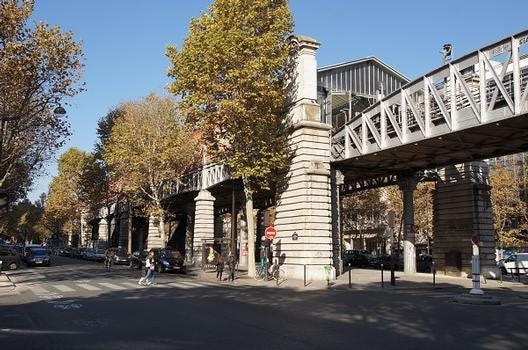

A while ago, I wrote about Paris metro line 6, one of my favorites. When it runs through the 13th arrondissement, the track is elevated above ground, passing through a gorgeous tree-lined boulevard. One of the stops is called Glacière, which is named for its ‘icy’ origin story that pre-dates the metro station.
Once upon a time, a river called the Bièvre flowed through Paris. It served as an important source for mills that once dotted the Parisian landscape. It later was used by tanners and manufacturers, but in 1912 most of the river was covered because the water was filthy and posed the threat of waterborne diseases.
There was one specific rural route that stretched along the Bièvre from Paris to the outlying area of Gentilly (see the map below). In the 17th century, it was known as ‘chemin de la Glacière’. When the river froze in winter, people would go ice skating on it. (Incidentally, the word ‘glace’ means ‘ice’ or ‘ice cream’ so you can see the linguistic connection.)
Folks realized they could use the ice from the frozen Bièvre to store for use year-round. Ice, after all, kept food cold enough to prevent quick spoiling — this was long before the refrigerator was invented in 1913.
There would be teams that would cut blocks of the frozen water and put them in wells that were 5-12 meters deep (16-40 feet) underground. There would be a number of ‘ice houses’ — known as glacières — that held supplies of ice. At one time, there were 40 glacières around Paris.
The ice blocks were packed in straw to keep them from melting too quickly. One of the places ice was stored was underground at Parc Montsouris in the 13th arrondissement.
Vendors would then go around town with frozen blocks packed in straw on horse-pulled carts shouting that they had ice for sale. Later, a more sophisticated system was created to ensure the daily delivery of ice to customers, sort of like what you’d see with the milkman.
And THIS, my friends, is how the Glacière metro got its name. The station was inaugurated in 1906. There is also a rue de la Glacière that intersects with the tree-lined boulevard I mentioned earlier, called Boulevard August Blanqui.
Sources:
Glacière : ce que cache le nom givré d’une station parisienne
Un jour, une station : Glacière, l’âge de glace | RATP
Le secret derrière les noms des stations de métro : Glacière – Paris ZigZag










I really enjoyed this — how something as ordinary as a metro stop can hide such charm and history! Thanks a lot for sharing!
I was looking forward to reading this! The Glacière station is prominently mentioned in that "Monstre dans le Métro" book I mentioned to you previously. It's also my favorite line. But I had never, ever, given any thought to the origin of the name.